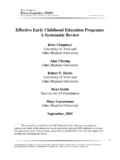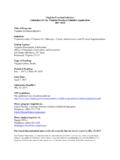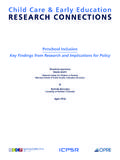Transcription of Investing in the Early Years—A National Early …
1 Investing in the Early Years A National Early childhood development StrategyAn initiative of the Council of Australian Governments2 July 2009 ISBN 978-0-642-77869-7 (PRINT) 978-0-642-77870-3 (PDF) 978-0-642-77871-0 (RTF) Commonwealth of Australia 2009 This work is copyright. Apart from any use as permitted under the Copyright Act 1968, no part may be reproduced by any process without prior written permission from the Commonwealth. Requests and inquiries concerning reproduction and rights should be addressed to the Commonwealth Copyright Administration, Attorney-General s Department, Robert Garran Offices, National Circuit, Barton ACT 2600 or posted at summary 4 Chapter 1 The Case for Change Introduction Why do we need a National strategy ?
2 6 Chapter 2 The National strategy a vision for Australia s children for 2020 The vision The outcomes framework Building an effective Early childhood development system Elements of an effective Early childhood development system 17 Chapter 3 Implementing the National strategy The approach Current commitments Immediate action Steps to address gaps Specific reform priorities to address gaps Next steps 30 Appendix 1 The evidence base 31 Early childhood development 31 Endnotes 37page 4 The shared vision of the Commonwealth and state and territory governments is that by 2020 all children have the best start in life to create a better future for themselves and for the for the National strategy A focus on the whole child, across cognitive, learning, physical, social, emotional and cultural dimensions and learning throughout lifeA focus on the whole of Early childhood , from the antenatal period to age 8A focus on all children, and providing additional help for those children most in need to reduce social inequalities A focus on enhancing positive factors and reducing risks for childrenA focus on the whole service system, covering both universal and targeted supports and services, across sectors and levels of government.
3 Including non-government agencies A focus on respect for diversity and difference as a strength, and helping children develop a positive sense of self and culture. Executive summary The National Early childhood development strategy , Investing in the Early Years (the strategy ), developed under the auspices of the Council of Australian Governments (COAG), is a collaborative effort between the Commonwealth and the state and territory governments to ensure that by 2020 all children have the best start in life to create a better future for themselves and for the nation. This is our strategy will guide Australia s comprehensive response to evidence about the importance of Early childhood development and the benefits and cost-effectiveness of ensuring all children experience a positive Early childhood , from before birth through the first eight years of life.
4 It will also support Australia to better meet the diverse needs of today s families and focus on improving child outcomes and foster the health and wellbeing and productivity of our next generation. National effort to improve child outcomes will in turn contribute to increased social inclusion, human capital and productivity in Australia. It will help ensure Australia is well placed to meet social and economic challenges in the future and remain internationally competitive. Our understanding of the interactions between genetics and Early childhood experiences has advanced through research in neurobiology which highlights the importance of the Early years in shaping the architecture of the children is the prime responsibility of families, parents and carers who have the most powerful influence on their child s life and development .
5 This strategy focuses on how Australia s Early childhood development system aims to engage with and respond to the needs of young children and their families so that Australia s young children have the best possible start in life. The strategy also highlights the important role of communities, non-government organisations and government in shaping children s Early childhood development . The strategy advocates for building on the substantial current investment being made to transform the way our nation responds to the needs of young children and their families. This entails implementing a range of existing reforms, rethinking current approaches, addressing gaps and building a strong Australian evidence strategy seeks to achieve positive Early childhood development outcomes and address concerns about individual children s development Early to reduce and minimise the impact of risk factors before problems become entrenched.
6 The aim is to improve outcomes for all children and importantly, reduce inequalities in outcomes between groups of children. This is especially important for some Indigenous children who, on average, have significantly poorer outcomes than non-Indigenous children. Specific outcomes for children relate to improved health, cognitive and social development leading to improved transition to school and improved educational, employment, health and wellbeing outcomes. In recognition of the critical role of families, the strategy seeks outcomes for families related to workforce participation and engagement of parents in understanding the importance of Early childhood development and in supporting their child s achieve these outcomes, the strategy details the areas where action is required to build system effectiveness and capacity and to address gaps in order to develop an effective Early childhood development system by 2020.
7 In addition to current commitments, page 5 a number of immediate actions and specific reform priorities have been identified where governments will work together to implement the strategy . In this context, it is important to note that the strategy builds on and links with a number of landmark Commonwealth election commitments and COAG Early childhood development reforms in 2008. These reforms represent a substantial new financial commitment. New commitments under the National Framework for Protecting Australia s Children, in particular, will make a significant contribution to implementing the strategy . This strategy will evolve and respond to the challenges and needs of Australia s children and families and the future reform opportunities that will help us deliver on our vision.
8 Crucial to this will be achieving broad, sustained and thoughtful discussion on how we as a nation can improve Early childhood reform initiatives that seek to improve Early childhood outcomes include:a National Partnership Agreement on Early childhood Education to achieve universal access to quality Early childhood education for all children in the year before school by 2013 a National Partnership Agreement on Indigenous Early childhood development to establish 35 new Children and Family Centres and to increase access to antenatal care, teenage sexual health and child and family health services for Indigenous children and familiesa six- year National Partnership Agreement on Preventive Health with a focus on strategies to prevent chronic diseases that commence in Early childhood a National quality agenda for Early childhood education and care which includes stronger standards, streamlined regulatory approaches.
9 A rating system and an Early Years Learning Frameworknational workforce initiatives to improve the quality and supply of the Early childhood education and care workforcethe Closing the Gap initiative which includes ambitious targets for Indigenous children related to infant mortality, literacy and numeracy and participation in quality Early childhood educationa National Framework for Protecting Australia s Children the Melbourne Declaration on Educational Goals for Young Australians a National Family Support Program which brings together eight Commonwealth programs for children, families and parentingpaid parental leave arrangements a National Plan to Reduce Violence against Women and Children development of an Early Intervention and Prevention Framework under the National Disability Agreementa National Partnership Agreement on Homelessness, with a focus on intervening Early for children and their families at risk of 6 Chapter 1 The Case for Change IntroductionThe strategy is based on clear evidence from Australia and overseas that the Early years of a child s life have a profound impact on their future health, development .
10 Learning and is of concern therefore that Australia is seeing increases in poor outcomes for children and young people in a number of key areas, and a widening of inequalities in outcomes between groups of are also signs that social changes over recent decades have impacted on family functioning and that some Early childhood development and family support services struggle to meet diverse family particular, more and more families rely on Early childhood services to support their workforce participation and the choices they make about how they balance work and family responsibilities. It is imperative to look at how policy, services, supports and programs may need to adjust to better support families with young children.






